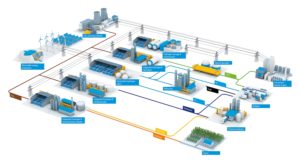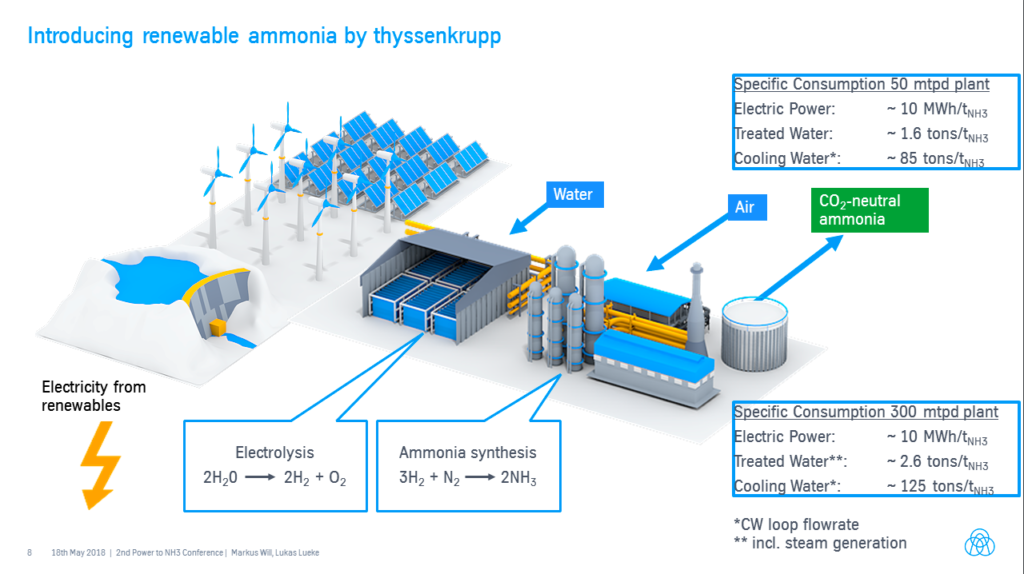ThyssenKrupp’s “green hydrogen and renewable ammonia value chain”
By Trevor Brown on July 26, 2018
In June, ThyssenKrupp announced the launch of its technology for “advanced water electrolysis,” which produces carbon-free hydrogen from renewable electricity and water. This “technology enables economical industrial-scale hydrogen plants for energy storage and the production of green chemicals.”
Two weeks later, in early July, ThyssenKrupp announced that it was moving forward with a demonstration plant in Port Lincoln, South Australia, which had been proposed earlier this year. This will be “one of the first ever commercial plants to produce CO2-free ‘green’ ammonia from intermittent renewable resources.”
The German conglomerate is one of the four major ammonia technology licensors, so its actions in the sustainable ammonia space are globally significant. ThyssenKrupp is also a member of the NH3 Fuel Association, the organization that publishes Ammonia Energy.
ThyssenKrupp’s ammonia synthesis technology was first launched by Uhde in 1928 and, by its own estimation, the company’s technology has been used in 130 ammonia plants in the last 90 years. Uhde also began making electrolyzers in the 1950s, primarily serving the chlorine production industry, where ThyssenKrupp now boasts a 49% market share as “supplier for electrolytic hydrogen production,” having built 600 electrochemical plants worldwide with an installed power rating of 10 GW. ThyssenKrupp also operates one of the few ammonia plant engineering, procurement, and construction (EPC) firms, through its subsidiary ThyssenKrupp Industrial Solutions (TKIS).
Those two technologies – ammonia and electrolyzers – have been integrated by the engineering division, and the company is now well-positioned to deliver the “green hydrogen and renewable ammonia value chain.”
Hydrogen Utility (H2U), the Australian hydrogen infrastructure firm, is the company developing the Port Lincoln demonstration plant. H2U first announced its plans in February 2018, at which time it named ThyssenKrupp as its EPC partner and provider of electrolyzer units. Now, the AUD$117.5 million (USD$95 million) project is moving forward with a bigger role for ThyssenKrupp, whose July 2018 announcement specified that it had “been awarded a contract to perform a feasibility study” for the Port Lincoln demonstrator.
According to ThyssenKrupp’s announcement, the Port Lincoln facility will include “a 30MW water electrolysis plant” (twice the size of the electrolyzer system announced in February 2018) and “an ammonia production facility with a capacity of 50 tons per day” (no capacity or technology provider had previously been specified for ammonia). ThyssenKrupp confirms that “both plants will be based on thyssenkrupp technology.”
Dr. Attilio Pigneri, CEO of H2U: “This project is an important milestone for Australia’s shift to a reliable renewable energy future. The new facility will provide balancing services to the national transmission grid, fast frequency response support to new solar plants under development, supply green ammonia and other chemicals to the local farming and aquaculture sectors. It will host the demonstration of novel supply chain technologies for the export of green hydrogen to markets in the Asia-Pacific region.”
ThyssenKrupp press release, thyssenkrupp supports Australian Company H2U in green hydrogen and renewable ammonia value chain development, 07/03/2018
H2U expects to sell the small quantity of green ammonia coming out of this facility into the local agriculture market, as fertilizer. A far greater opportunity, however, is in the development of new markets for ammonia. This is, after all, a demonstration plant: it will be demonstrating the techno-economic viability of the “green hydrogen and renewable ammonia value chain,” and the role of ammonia in Australia’s “renewable energy future.”
As I explained in my February 2018 article, when this project was first announced, when Pigneri talks about demonstrating “novel supply chain technology for the export of green hydrogen,” he is talking about producing ammonia as an exportable energy commodity.
As Pigneri explained in an interview this week with local media, the true potential of using renewable hydrogen to make ammonia is not found in selling small amounts of distributed green fertilizer, but in exporting vast quantities of the hydrogen-dense chemical into low-carbon energy markets.
The focus of this demonstration is not really the technology at all, but the business model. H2U is pushing the project forwards “with the hope of opening up an industry that proponents say could eventually surpass the value of Australia’s multi-billion-dollar gas exports … an estimated $23 billion of [LNG] in 2016-17” …
“It’s really about market development,” Pigneri told InDaily.
AmmoniaIndustry.com, Renewable ammonia demonstration plant announced in South Australia, 02/16/2018
This potential market for ammonia – energy – is not shown in ThyssenKrupp’s illustration of its “hydrogen value chains,” published in June to accompany the launch of its electrolyzer technology. Nonetheless, this market presents a significant commercial opportunity, and this demonstration facility presents an ideal learning ground.
As I reported in May 2018, ThyssenKrupp introduced its integrated ‘green ammonia’ plant at the NH3 Event in Rotterdam. Its initial engineering concept comes in two sizes: a 50 ton per day ammonia plant requiring 20 MW of power, which is now proposed for the demonstration facility in Port Lincoln, and a 300 ton per day ammonia plant requiring 120 MW.
As ThyssenKrupp’s recent announcement makes clear, its electrolyzer system is not new but, rather, it is a mature, optimized, proven technology.
The advanced water electrolysis features a well-proven cell design paired with an especially large active cell area of 2.7 m2. By further optimizing the proven ‘Zero-Gap’ electrolysis technology (leaving virtually no gap between membrane and electrodes), very high efficiencies of more than 82% are achieved.
Sami Pelkonen, CEO of the Electrolysis & Polymers Technologies business unit at thyssenkrupp Industrial Solutions: “With our water electrolysis process, we have successfully brought a technology to market maturity which is of major significance for the energy transition.”
ThyssenKrupp press release, Key to a sustainable future: thyssenkrupp launches advanced water electrolysis, 06/20/2018
The electrolyzer technology, and its engineering package together with the ammonia synthesis technology, is modular. This is the nature of electrochemical technology: electrolyzers don’t really exhibit economies of scale, unlike steam methane reformation (SMR) units, which are the conventional source of hydrogen for ammonia plants. For this reason, it is important to note that the projected energy efficiency of ThyssenKrupp’s integrated process is 10 MWh per ton ammonia, roughly equivalent to 36 GJ per ton, and equal to today’s global average for ammonia plant efficiency.
For now, 10 MWh per ton will be the benchmark for the energy efficiency of Haber-Bosch ammonia plants using a feedstock of electrolytic hydrogen.
The Port Lincoln demonstration plant in South Australia will, therefore, not be the most energy efficient ammonia plant on the planet but it will be commercial and competitive. Moreover, for ThyssenKrupp, the modularity of this technology opens up new opportunities, unavailable to SMR-fed ammonia plants. Its green ammonia plant can be pre-fabricated, reducing project risk. It can be “daisy-chained,” linking many individual units to increase total plant capacity up to any desired scale. And it can be mass-produced.
To make deployment of large hydrogen projects as easy as possible, the thyssenkrupp technology is available in pre-fabricated, skid mounted standard modules. They easily add up to the desired project size, potentially into the hundreds of megawatt range …
“Based on decades of experience in developing and building electrolysis plants, we have designed our product to meet our client’s most important demands: easy to deliver and install, highly efficient, with minimized investment and operation cost. And we have an industrial-scale supply chain of 600 MW per year already in place”, says Roland Käppner, Head of Energy Storage and Hydrogen at thyssenkrupp Uhde Chlorine Engineers.
ThyssenKrupp press release, Key to a sustainable future: thyssenkrupp launches advanced water electrolysis, 06/20/2018
These are valuable attributes, and they are already allowing ThyssenKrupp to market the technology in new regions:
As renewable energy sources continue their global success story, the demand for integrating them into the current South African energy and industry landscape grows. Hydrogen production is suitable for long-term energy storage, hydrogen mobility and other applications to make optimal use of renewable energy sources.
The technology has also been developed in prefabricated skid-mounted standard modules and can be deployed anywhere on the continent with minimal construction risks, says Thyssenkrupp Industrial Solutions sub-Saharan Africa CEO Philipp Nellessen …
“While renewables still form a small percentage of the South African energy landscape, this technology is potentially a fundamental building block to a variety of renewable energy initiatives that are currently on the country’s Integrated Energy Plan agenda,” said Nellessen.
Creamer Media Engineering News, Thyssenkrupp launches industrial-scale water electrolysis solution for large projects, 07/13/2018

